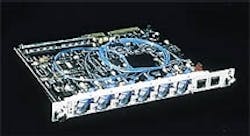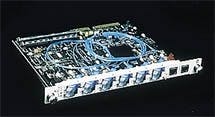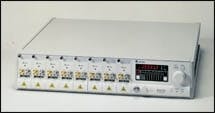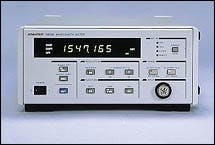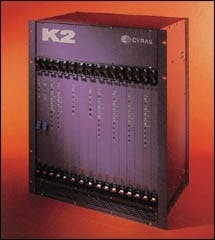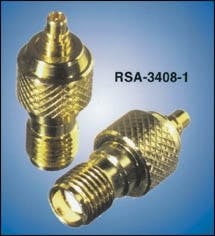Premier Products
Compiled by Sue Boyle
For immediate response, go to www.onlinecenter.to/LW
SYSTEMSAIflex allows customers with access to fiber-optic lines to extend their LAN, providing the bandwidth to support both enterprise applications and operation, administration, maintenance, and provisioning. AIflex has obtained Network Equipment Building Standard level 3 certification. The AIflex is used to extend LANs by either utilizing unused fiber or WDM technology. Management data may be sent on the same fiber line as SONET or DWDM with AIflex without interfering with the existing payload or needing to bring down the fiber during installation. Provisioning time is reduced with no wait for T1 engineering and provisioning. The T1 line installation cost and monthly recurring costs are eliminated.
Applied Innovation Inc.
Dublin, OH
The ECL-210 has been developed to meet customers' demands for a fully electronically tunable external-cavity laser. It is utilized to ensure that all wavelengths can be selected accurately and with excellent stability in both wavelength and power. The slimline 19-inch rack houses up to eight channels and allows for full control through the GPIB or RS-232 interfaces. The ECL-210 has a full 80-nm tuning range and covers DWDM system wavelengths between 1,460 and 1,640 nm. The wide tuning range is complemented by high output power up to 10 mW and wavelength and power stabilities of better than 0.01 nm and 0.01 dB, respectively.
Santec Corp.
Oxford, UK
The Q8326 Optical Wave length Meter tests next-generation transmission laser diodes whose tolerances have narrowed due to the increased bandwidth demands of the Internet. The Q8326 enables designers, manufacturers, and users of DWDM components to quickly and accurately test the compliance of transmission laser diodes and optical filters. It has a high wavelength accuracy of ±2 parts per million and makes measurements with a high resolution of up to 0.1 pm. A sampling rate of five measurements-per-second enables a quick evaluation of laser diodes. The deviation display function allows the Q8326 to capture any minute wavelength fluctuations caused by temperature variations.
Tektronix Inc.
Atlanta
The polarization-mode dispersion compensator (PMDC) eliminates distortion of optical signals over fiber-optic networks caused by asymmetries in fiber. The PMDC alleviates optical-signal distortion by adaptively canceling the polarization-mode dispersion at the receiver. The result is a cost-effective and reliable solution that alleviates the distortion. Additional features of the PMDC include a small footprint, low power dissipation, and a solid-state design.
YAFO Networks Inc.
Hanover, MD
This broadband, inline fiber depolarizer operates over the entire transmission network window (1,300-1,610 nm). The all-fiber depolarizer features a fused-fiber construction with no free-space optics, moving parts, or bending in the light path. Designed for use with Raman lasers, the depolarizers offer unpolarized light with DOP less than1% and feature low insertion loss. The standard devices are insensitive to input polarization changes, and environmental effects can be integrated directly as a part of the optical source. The devices are light, ruggedized, and operate ov er a wide wavelength range; they are available in a compact box or customized packaging.
ProtoDel International Ltd.
Hackbridge, Surrey, UK
The K2 uses powerful switching technologies that help carriers transcend metro gridlock, supercharging their optical networks with scalable, data-optimized, multiservice optical gear that integrate seamlessly and cost-effectively into existing metro access, metro transport, and metro core deployments. The K2 uses a combination of statistical multiplexing aggregation, preservation of native traffic protocols, arbitrary concatenation of SONET with traffic-based dynamic provisioning, and data grooming across the trans-metro. The K2's unconstrained architecture provides carriers with unmatched granularity and scalability from fractional DS-1 to multiple OC-192s, while supporting all prevailing packet and circuit-switching transport protocols. According to the company, the K2 is the only platform to support multiple simultaneous protection schemes as well as any topology.
CYRAS Systems Inc.
Fremont, CA
The ATA7600D1 differential transimpedance amplifier (TIA) meets the performance and bandwidth demands of DWDM OC-192 systems driven by the increased demand for high-speed Internet connectivity. Operating at + 5 VDC, the InGaP HBT TIA provides low power consumption, low group delay, high gain, and low noise performance to enable high-speed, broadband fiber-optic systems. The ATA7600D1 is uniquely suited for 10-Gbit/sec and DWDM applications. The benefits of InGaP HBT processing include high reliability, resistance to temperature influences, and excellent performance uniformity. The ATA7600D1 dissipates a maximum of 500 mW and offers good gain flatness, low group delay (-20 to +20 psec), and low noise for WDM and DWDM applications. With a 9-GHz typical bandwidth, the TIA features a 0 dBm to -18.5 dBm dynamic optical range with a 1,550-nm PIN photodiode.
Anadigics
Warren, NJ
This handheld cartridge dispenser is designed to take the guesswork out of mixing two-part curing optical gels. The dispenser is ideal for prototyping and other small-quantity applications. The cartridge dispenser is designed for high-clarity optical gels to ensure thorough mixing and prevent air-bubble entrainment in these manual, small-quantity applications. The reusable dispenser holds a 50-cc cartridge. The cartridge is inserted into the dispenser, and the plunger is depressed, mixing and applying the two components in proper ratio.
Nye Optical Products
Fairhaven, MA
The MMCX plug adapter is designed for optimal performance in the 0- to 6-GHz frequency range. It features gold-plated machined brass body, gold contacts, and PTFE insulation. The knurled band on the body provides enhanced gripping for installation of the adapter.
RF Connectors
San Diego
The TRA-BOND 2115 is an optically clear, low-viscosity material suggested for use in the fabrication of lasers. Its low shrinkage during cure makes this product ideal for laser and optical component applications where proper alignment is critical. It has been known to withstand 30 sec of 60-W direct laser energy and has also been cycled to 4k in cryogenic applications. This two-part epoxy system is easily mixed and cured at room temperature, but heat can be applied to reduce cure time to a matter of hours. The TRA-BOND 2115 is a high-strength material that bonds to a wide variety of substrates, including glass, metals, ceramics, and many plastics.
Tra-Con Inc.
Bedford, MA
The IN-Cabinet Cable Management System is designed to manage and organize patch cords and distribution cables within a cabinet. The system works with most of the leading cabinet designs and includes provisions for managing cables both horizontally and vertically. The system consists of vertical panels offered in various sizes and two slot types of mounting configurations mounted to the rails of cabinets 27 inches or wider. The slotted duct on each panel is designed to make exit and entry into the cable-management system quickly and easily. The cable-management system is designed for use in multimedia applications.
Panduit Corp.
Tinley Park, IL
The E6091A OTDR Toolkit II is a software package for use with any of its optical time-domain-reflectometer (OTDR) products. The software reduces the time needed for post-processing fiber measurement data through the use of advanced batch-mode and reporting functions. By organizing a single project test for a cable carrying hundreds of optical fibers, engineers and central-office planners get a better view of all their system-integration or installation projects. The toolkit allows them to create a customized event table for compiling acceptance reports and creating work orders for resplicing and repair. The software can show up to 40 individual traces on a display screen. In post-processing data, engineers or supervisors can use the toolkit to replicate the multifiber test principle characterized in testing with the company's E6000B Mini-OTDR, instead of analyzing each individual fiber or event. They can batch process two-way averaging and pass/fail data to cut post-processing time from days to minutes.
Agilent Technologies Inc.
Santa Clara, CA
The Optical Performance Monitor (OPM) offers high wavelength accuracy suitable for wavelength locking in a small card-size design. The OPM measures critical optical parameters used to control systems, resulting in higher efficiency and less downtime. The OPM measures optical power, wavelength, and signal-to-noise ratio. With the OPM, slight deviations in performance are immediately detected, and information is provided that can be used to prevent system failures. Applications for the OPM include power equalization, multichannel wavelength locking, long-term span monitoring, system commissioning, and fault sectionalization. The OPM is less than 1 inch thick with a customizable footprint, supplies a peak power range of +5 to -50 dB, and has optical signal-to-noise ratio monitoring capabilities of 25 to 30 dB.
E-Tek Dynamics Inc.
San Jose, CA
The SSB-9200 High-Density Source Bank is the first member of this family of products designed in response to the increasing complexity and demands of WDM component, amplifier, and system testing. It can accommodate up to 48 individual DFB laser sources for high-channel-count systems. The DFB modules, offering customer-specific center wavelengths between 1,528 nm and 1,610 nm with ±0.85-nm tuning, are available in powers of 10 mW or 29 mW. The SS-810 source shutter is available for applications where the light must be extinguished without turning off the drive current to the laser. The mainframe has a fast GPIB/IEEE 488.2 communication platform.
ILX Lightwave Corp.
Bozeman, MT
